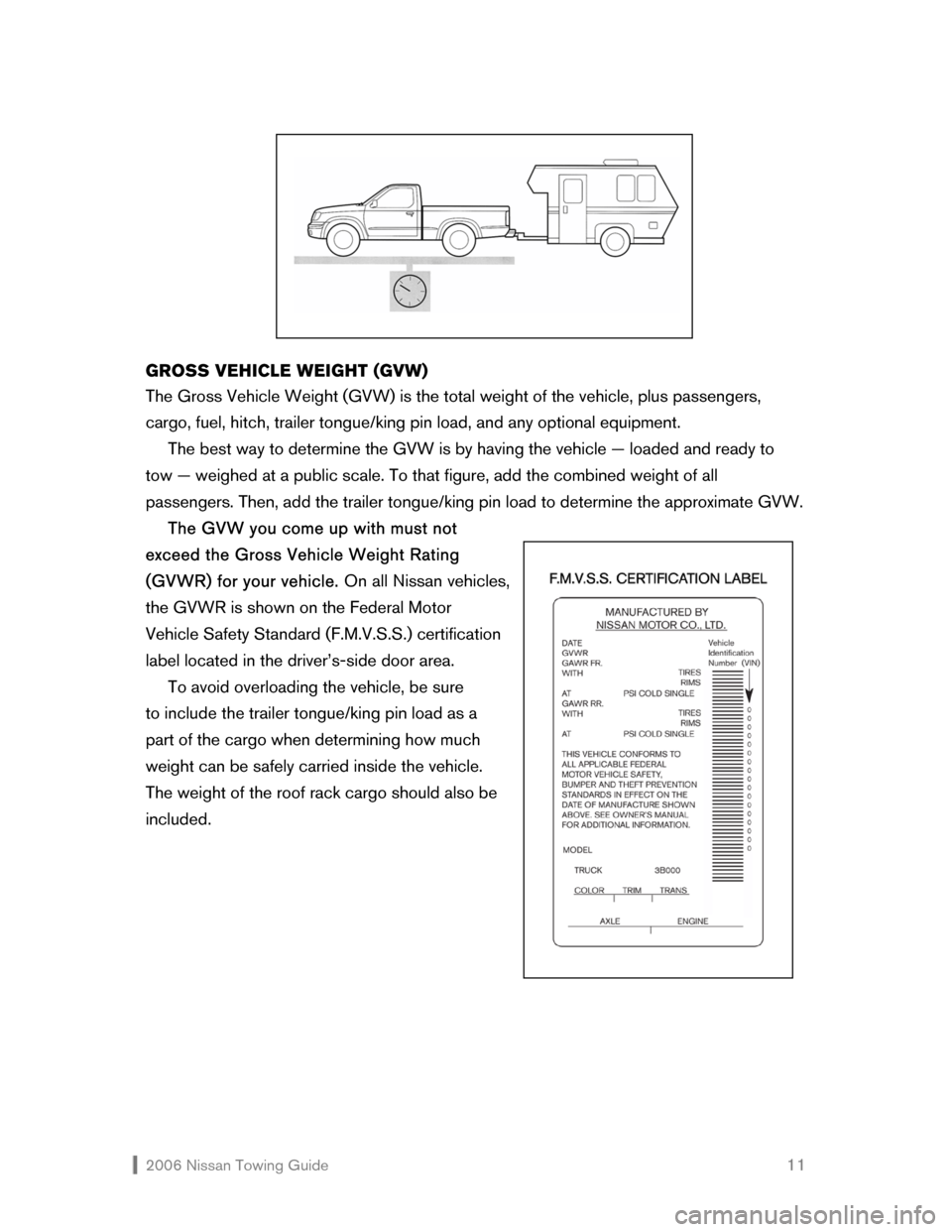2006 NISSAN FRONTIER tow
[x] Cancel search: towPage 9 of 28

2006 Nissan Towing Guide 8 BREAKAWAY SWITCH
On a trailer with electric brakes, a breakaway switch can automatically activate the trailer
brake system if the trailer becomes separated from the tow vehicle. Should the trailer
become detached, a breakaway switch may help prevent the trailer from wandering into
another lane and will bring it to a safer stop with less damage.
A breakaway switch relies on the power of a trailer battery, so make sure it is not
discharged. Never use the breakaway switch to “park” the trailer on a grade. The battery
would eventually discharge and release the brake, allowing the trailer to roll.
Be sure to leave enough slack in the tether on the breakaway switch to turn corners
without binding. If not, the electric trailer brakes will lock-up and not release.
See your trailer manufacturer for proper installation of a breakaway switch that is
compatible with your trailer braking system.
TRAILER LIGHTS
Trailer lights should comply with all applicable federal, state, and local regulations, and
should be in proper working order at all times. A trailer’s taillights, stoplights, and turn
signals must be wired* into the tow vehicle’s electrical system. Many trailers use the same
filament of a dual-filament bulb for both stoplights and turn signals. The second filament is
used for the trailer’s taillights. All Nissan vehicles utilize separate filaments for each
function. Direct splicing of this type of trailer lighting may cause damage to your vehicle’s
electrical system and malfunction of the trailer lighting. When connecting your Nissan
vehicle to this type of trailer lighting system, a 3-wire to 2-wire power converter** must be
used. A power converter of this type creates only minimal additional demand (draw) on the
vehicle lighting circuits to power the trailer lighting.
Always check for correct operation of the turn signals, stoplights, and taillights every
time you connect a trailer for towing. Never replace vehicle fuses with fuses of a higher
amperage rating than the original.
NOTE – Improper or poor quality trailer harness wiring may affect your vehicle’s electrical
system. Use only a Nissan approved wiring harness, or consult your dealer or a
professional supplier of towing equipment for compatible equipment.
*See the SPECIFICATIONS section of this guide for wiring harness information specific to your
vehicle.
**Armada, Frontier, Pathfinder, Titan, and Xterra vehicles are pre-wired for trailer lighting and do not
require a converter.
Page 10 of 28

2006 Nissan Towing Guide 9 BRAKES
As with hitches, there are several types of braking systems available. Most states require a
separate braking system on trailers with a loaded weight above a specific amount, so
check to ensure you comply with all regulations.
NOTE – Never connect a hydraulic trailer brake system directly to the vehicle
hydraulic brake system.
Surge Brakes – The surge brake is mounted on the trailer tongue with a hydraulic line
running to each trailer wheel. Surge brakes are activated by the trailer pushing against the
hitch when the tow vehicle is braking. Hydraulic surge brakes are common on rental trailers
and some boat trailers. In this type of system, there is no hydraulic or electric connection
for brake operation between the tow vehicle and the trailer.
Electric Trailer Brakes – Electric braking systems are activated by an electronic signal
sent from a trailer brake controller (special brake-sensing module).
If electric trailer brakes are used, Nissan recommends all-electronic actuation because
with this system it will not be necessary to tap into the tow vehicle’s hydraulic system.
For your convenience, Armada, Frontier, Pathfinder, Titan, and Xterra vehicles are pre-
wired to accommodate most popular electric trailer brake controllers. A wiring harness* is
either included with your vehicle or available from your Nissan dealer. This harness
provides electric trailer brake controller input and output connections to the vehicle wiring.
See a professional supplier of towing equipment for electric trailer brake controller
availability.
NOTE – Improper or poor quality trailer harness wiring may affect your vehicle’s electrical
system. Use only a Nissan approved wiring harness, or consult your dealer or a
professional supplier of towing equipment for compatible equipment.
GENUINE NISSAN PARTS AND ACCESSORIES
Whether you’ll be towing occasionally or on a regular basis, Nissan offers a full range of
Genuine Nissan Parts and Accessories to help you tow with confidence.
Every accessory is thoroughly tested and inspected for fit and workmanship. Therefore,
you can be certain that every item is designed to be compatible with the standard features
of your vehicle and designed to assist you with your towing needs.
Contact your Nissan dealer for more information on accessories or towing-related parts
for your Nissan vehicle.
*See the SPECIFICATIONS section of this guide for wiring harness information specific to your
vehicle.
Page 11 of 28

2006 Nissan Towing Guide 10
PREPARING
YOUR VEHICLE
BREAK-IN AND MAINTENANCE SCHEDULE
Nissan recommends that you allow a sufficient “break-in” (500 miles) of both the engine
and drivetrain before towing with your new Nissan vehicle. For the first 500 miles that you
tow a trailer, do not drive over 50 mph.
Keep in mind, too, that towing places higher demands and added loads on vehicle
components, so more frequent maintenance is called for. Your service maintenance guide
provides the accelerated maintenance schedule for towing purposes. Engine oil, filter,
transmission oil, and possibly other fluids should be changed more frequently when towing.
MEASURING VEHICLE WEIGHT
The key to safe, efficient towing has to do with weight. Your vehicle — SUV, truck, Minivan,
or passenger car — is capable of carrying and towing only a certain amount of weight. You
must compare your vehicle’s tow-weight ratings with the combined weight of the vehicle,
trailer, and their contents. This will help ensure that the total weight does not exceed any of
your vehicle’s tow weight ratings. There are four weights to consider when towing:
�Š Gross Vehicle Weight
�Š Gross Axle Weight (Front and Rear)
�Š Gross Combined Weight
�Š Trailer Tongue/King Pin Load
These ratings are based upon normal highway driving and may be reduced if operating in
reduced-traction situations, e.g., slippery boat ramps.
NOTE – Attempting to tow loads greater than the GVWR, GAWR, GCWR, and the trailer
tongue/king pin load specified could adversely affect vehicle handling, braking, and
performance. Damage to your vehicle resulting from overloading may not be covered by
your vehicle warranty.
Page 12 of 28

2006 Nissan Towing Guide 11
GROSS VEHICLE WEIGHT (GVW)
The Gross Vehicle Weight (GVW) is the total weight of the vehicle, plus passengers,
cargo, fuel, hitch, trailer tongue/king pin load, and any optional equipment.
The best way to determine the GVW is by having the vehicle — loaded and ready to
tow — weighed at a public scale. To that figure, add the combined weight of all
passengers. Then, add the trailer tongue/king pin load to determine the approximate GVW.
The GVW you come up with must not
exceed the Gross Vehicle Weight Rating
(GVWR) for your vehicle. On all Nissan vehicles,
the GVWR is shown on the Federal Motor
Vehicle Safety Standard (F.M.V.S.S.) certification
label located in the driver’s-side door area.
To avoid overloading the vehicle, be sure
to include the trailer tongue/king pin load as a
part of the cargo when determining how much
weight can be safely carried inside the vehicle.
The weight of the roof rack cargo should also be
included.
Page 13 of 28

2006 Nissan Towing Guide 12
GROSS AXLE WEIGHT (GAW)
The Gross Axle Weight (GAW) is the maximum weight each axle (front and rear) is
designed to safely carry.
To determine the GAW, load the vehicle as you would for towing and attach the loaded
trailer. At a public scale, with the loaded trailer attached, place only the tow vehicle front
wheels on the scale to determine the actual front axle GAW. To obtain the rear axle GAW,
place all four tow vehicle wheels on the scale. From that figure, subtract the front GAW
and you’ve got the rear GAW amount.
The GAW you come up with must not exceed the Gross Axle Weight Rating
(GAWR) for your vehicle. On Nissan vehicles, the GAWR for both axles is listed on the
F.M.V.S.S. certification label.
GROSS COMBINED WEIGHT (GCW)
The Gross Combined Weight (GCW) is the total weight of the tow vehicle with all
passengers, cargo, and fuel, plus the total weight of the trailer and all its cargo.
To determine the GCW, simply weigh your vehicle when fully loaded and ready to tow,
and add in the weight of the loaded trailer.
The GCW you come up with must not exceed the Gross Combined Weight Rating
(GCWR) for your vehicle. See the SPECIFICATIONS section of this guide, or refer to
your owner’s manual to view the GCWR listed for your vehicle.
Page 14 of 28

2006 Nissan Towing Guide 13 TRAILER TONGUE/KING PIN LOAD
The amount of weight pressing down on the tow vehicle hitch is called trailer tongue load
(conventional trailer) or king pin load (5th wheel or gooseneck trailers). To measure trailer
tongue/king pin load, place the tongue of the trailer on a scale when the trailer is not
attached to the vehicle. A separate vehicle jack — not the trailer jack — should be used, as
the location of the trailer jack
is rearward of the trailer
tongue and will not give you
an accurate measurement of
the true tongue/king pin load.
Make sure the vehicle jack is
placed directly under the
trailer tongue coupler, and the
tongue is set at the
height/level of the tow vehicle
hitch.
For proper handling, keep conventional trailer tongue load between 10-15% of the
actual trailer weight, within the limits of the maximum trailer tongue load allowable. For
example, to determine the proper trailer tongue load for a 1,500-lb. trailer, multiply the
weight of 1,500 lbs. by 10% to arrive at a figure of 150 lbs.
5th wheel and gooseneck trailer king pin load should be kept between 15-25% of the
actual trailer weight.
See the SPECIFICATIONS section of this guide, or refer to your vehicle owner’s manual
to view the maximum conventional trailer tongue load listed for your vehicle.
NOTE – Conventional trailer tongue load must be more than 10% but not over 15% of the
total trailer weight. King pin load must be more than 15% but not over 25% of the total
trailer weight. The vehicle weight ratings (GVWR, GAWR, GCWR, etc.) must not be
exceeded, regardless of trailer or hitch type.
HITCH HEIGHT/TRAILER HEIGHT
It is important that your trailer floor and
tongue ride as level as possible. This will help
prevent over-angling, bottoming-out, and
improper load transfer. Therefore, the hitch or
trailer tongue should be adjusted during the
initial vehicle/trailer fit-up to ensure a level
ride. Ball mounts are available in different
configurations to change the hitch ball height.
Page 15 of 28

2006 Nissan Towing Guide 14 TIRE PRESSURE
When towing a trailer, increase tow vehicle tire pressures to the recommended cold
specifications. You’ll find these figures in the owner’s manual and on the tire pressure chart
located in the vehicle. Trailer tire condition, size, load rating, and inflation pressure should
be in accordance with the trailer and tire manufacturer’s specifications.
TOWING
SAFETY
Towing can dramatically alter the handling and performance characteristics of your vehicle.
Plus, it puts increased strain on the engine and drivetrain. Therefore, it is always a good
idea to approach towing from the standpoint of safety — whether you’re purchasing
equipment or actually pulling the trailer.
Always make sure your vehicle’s towing capacity is adequate for the trailer you intend to
tow. Buy or lease only quality equipment, and have it installed only by professionals.
In addition, be certain that you have all of the equipment needed for safe towing,
including safety chains/cables, electric trailer brakes, electric trailer brake controller,
breakaway switch, extended rear view mirrors, and so on. All of these items have been
discussed in a previous section of this guide.
With regard to vehicle maintenance, you should follow a more frequent schedule, and
check fluid levels, pressures, tire condition, etc., more often when on the road. See your
owner’s manual for details.
LOADING YOUR TRAILER
Taking the time to load and balance your trailer properly will improve overall handling and
minimize the strain on your tow vehicle. Incorrectly loaded trailers tend to sway or swing
from side to side, upsetting vehicle handling. Careful loading and balancing can help
eliminate these problems.
As mentioned earlier, conventional trailer tongue load should fall between 10-15% of
the total trailer weight, and king pin load — if using a 5th wheel or gooseneck trailer —
should be between 15-25% of the total trailer weight. Excessive tongue/king pin load can
actually push the vehicle down in back, lifting the front wheels to a point where traction,
steering response, and braking are severely reduced. Insufficient tongue/king pin load can
cause instability, which may lead to “tail wagging” or jackknifing.
Page 16 of 28

2006 Nissan Towing Guide 15 With this in mind, proper loading is
extremely important. When loading a trailer,
60% of the total cargo weight should be
positioned in the front portion of the trailer
and 40% in the back. Then, the load should
be adjusted until the proper tongue/king pin
load ratio is achieved.
The trailer load should be balanced
equally from side-to-side. Unequal side-to-
side loading can negatively affect handling
and braking. Once in place, all cargo should
be firmly secured to prevent shifting. If the
load should shift abruptly during braking or
cornering, it could quickly affect the
handling of your vehicle and cause a very
unsafe situation.
Finally, do not carry flammable materials,
such as gasoline, in your trailer. In the event
of an accident, an explosion or fire could
occur.
ENSURING VEHICLE/TRAILER STABILITY
Improper loading, excessive or insufficient trailer tongue/king pin load, overloading,
excessive trailer weight, poorly designed trailer suspensions, crosswinds, and poor
maintenance are all things that can affect the stability of your vehicle/trailer combination.
If swaying does occur, check the cargo load for proper balance and distribution to
ensure proper trailer tongue/king pin load. In addition, check the condition of the
suspension and shocks, as well as the tires, tire pressures, and wheel bearings on both the
tow vehicle and the trailer. If swaying occurs because of high winds or poor weather
conditions, wait until these conditions improve before resuming your trip.
If the swaying continues and you feel your trailer is suitably balanced and within the
towing capacity limits of your vehicle, discontinue towing and consult your Nissan dealer or
trailer manufacturer to determine the problem. Most important, do not tow until the problem
is corrected.